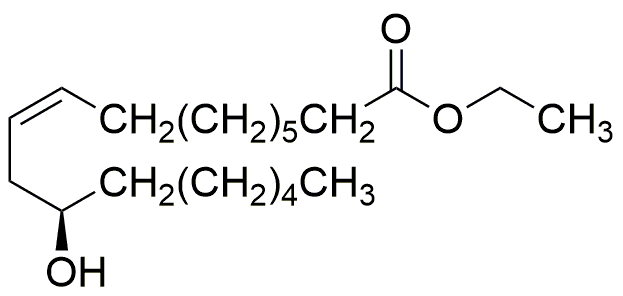Ethyl ricinoleate is widely utilized in research focused on various applications:
- Cosmetics and Personal Care: This compound serves as an effective emollient and skin-conditioning agent in lotions and creams, enhancing moisture retention and providing a smooth feel.
- Food Industry: It acts as a natural emulsifier in food products, helping to maintain texture and stability, which is particularly beneficial in sauces and dressings.
- Pharmaceuticals: Ethyl ricinoleate is used in drug formulations for its ability to improve solubility and bioavailability, making medications more effective.
- Biodegradable Plastics: This compound is incorporated into eco-friendly plastic production, offering a sustainable alternative to traditional petroleum-based plastics.
- Lubricants: It is utilized in the formulation of biodegradable lubricants, providing excellent lubrication properties while being environmentally friendly.
General Information
Properties
Safety and Regulations
Applications
Ethyl ricinoleate is widely utilized in research focused on various applications:
- Cosmetics and Personal Care: This compound serves as an effective emollient and skin-conditioning agent in lotions and creams, enhancing moisture retention and providing a smooth feel.
- Food Industry: It acts as a natural emulsifier in food products, helping to maintain texture and stability, which is particularly beneficial in sauces and dressings.
- Pharmaceuticals: Ethyl ricinoleate is used in drug formulations for its ability to improve solubility and bioavailability, making medications more effective.
- Biodegradable Plastics: This compound is incorporated into eco-friendly plastic production, offering a sustainable alternative to traditional petroleum-based plastics.
- Lubricants: It is utilized in the formulation of biodegradable lubricants, providing excellent lubrication properties while being environmentally friendly.
Documents
Safety Data Sheets (SDS)
The SDS provides comprehensive safety information on handling, storage, and disposal of the product.
Product Specification (PS)
The PS provides a comprehensive breakdown of the product’s properties, including chemical composition, physical state, purity, and storage requirements. It also details acceptable quality ranges and the product's intended applications.
Certificates of Analysis (COA)
Search for Certificates of Analysis (COA) by entering the products Lot Number. Lot and Batch Numbers can be found on a product’s label following the words ‘Lot’ or ‘Batch’.
*Catalog Number
*Lot Number
Certificates Of Origin (COO)
This COO confirms the country where the product was manufactured, and also details the materials and components used in it and whether it is derived from natural, synthetic, or other specific sources. This certificate may be required for customs, trade, and regulatory compliance.
*Catalog Number
*Lot Number
Safety Data Sheets (SDS)
The SDS provides comprehensive safety information on handling, storage, and disposal of the product.
DownloadProduct Specification (PS)
The PS provides a comprehensive breakdown of the product’s properties, including chemical composition, physical state, purity, and storage requirements. It also details acceptable quality ranges and the product's intended applications.
DownloadCertificates of Analysis (COA)
Search for Certificates of Analysis (COA) by entering the products Lot Number. Lot and Batch Numbers can be found on a product’s label following the words ‘Lot’ or ‘Batch’.
*Catalog Number
*Lot Number
Certificates Of Origin (COO)
This COO confirms the country where the product was manufactured, and also details the materials and components used in it and whether it is derived from natural, synthetic, or other specific sources. This certificate may be required for customs, trade, and regulatory compliance.


